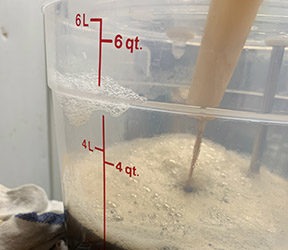21% Alcohol All-Grain Beer

Have you ever tried to do something, just because somebody told you it could not be done? A friend in my local homebrew club — Golden Triangle Homebrewers Club in Southeast Texas — told me it was impossible to brew an all-grain beer over 20% ABV. He then went on to say that he had read 16% was the highest I could ever expect to achieve as a homebrewer. EVER. Well, that night I could not fall asleep because I was thinking about how to brew a 20% ABV all-grain beer. I woke up thinking about it and over the next several weeks, reading and researching big-beer brewing took most of my spare time. The result was an extreme homebrewed all-grain old ale.
My challenge was to pass 20% ABV with all-grain procedures, so without beating around the bush any more, here is my recipe and brewing procedures.
Procedures
To begin with, I made a 1-gallon (3.8-L) yeast starter at a specific gravity of 1.066. The starter was fermented in a 6.5-gallon (25 L) carboy. (If you try this, keep track of the volume and gravity of your starter, as you will need this information to calculate your wort gravity accurately).
I pitched the starter with White Labs WLP099 (High Gravity) yeast. According to the White Labs website, it can ferment beers to 25% ABV.
I mashed 31 lbs. (14 kg) of Maris Otter malt at 146 °F (63 °C) overnight. (If you try this, you only need to mash until conversion is complete). You’ll need at least 9.5 gallons (37 L) of mash liquor for a mash thickness of 1.25 quarts per pound (2.6 L/kg). At this thickness, the whole mash will fit comfortably in a converted keg (or keggle, as they’re sometimes called).
I sparged very slowly until all the sugar was extracted. I ended up collecting 18 gallons (68 L) of wort in two kettles. Be sure to plan far enough ahead that your sparge water is ready.
I then boiled down the wort — in the two separate pots — to 4 gallons (15 L). I boiled slowly to reduce caramelization. I also put a clip-on fan on each pot, blowing on the surface of the wort. This was intended to prevent boil overs and it worked. (It really did, I don’t brew without one now.) I also suspect it caused the wort to boil down much faster by blowing the steam away.
I added my hops for the final 60 minutes of boil. In a normal gravity wort, they would yield a calculated value of over 100 IBUs. Given the extremely high gravity of the wort, I am not sure what a reasonable calculated IBU value would be. The final 4.0 gallons (15 L) wort had an original gravity (OG) of 1.246. Combined with the 1-gallon (3.8-L) starter, I calculated an OG of 1.210.
I then added only 1.0 gallon (3.8 L) of OG 1.246 wort to the 1-gallon (3.8-L) starter. I oxygenated the combined wort for 15 minutes with oxygen (O2) and affixed an airlock. For oxygenation, I used a small welding oxygen cylinder I bought just for brewing. If you are using air, you should probably aerate longer.
I canned the remaining 3 gallons (11 L) of high-gravity wort in 1 quart (~1 L) mason jars, the kind used in food preservation. To do this, I just siphoned the wort — which is so thick that it siphons very slowly — into jars. I set the lids on loosely and placed them in a water bath, which I then boiled for 15 minutes. After boiling, I tightened the lids. The reason I canned the wort and set it aside was to add the wort to the fermentation in stages. (See the September 2006 issue of BYO and the October 2006 Mail column for more on canning wort.) By adding fresh wort every time the main fermentation subsides, the gravity of the fermenting wort will remain relatively low. This was intended to allow the yeast to work in a less stressful environment than a standard high-gravity fermentation (when the yeast has to deal with all of the high-gravity wort at once).
At each stage, I let the beer ferment until fermentation activity subsided noticeably. I waited until the rate of bubbling in the airlock was less than one bubble every 30 seconds.
After the fermentation slowed, I added one quart (~1 L) of high-gravity wort and oxygenated the beer for 5 minutes minimum with O2. The oxygenation is essential to keep the yeast population healthy and able to pass 20% ABV. I added fresh wort every time fermentation slowed and aerated after each addition. After the final addition of wort, I let the whole thing ferment out.
When the yeast had consumed all the sugars it could from my wort, I added 8 crushed Beano tablets. The idea was to break down unfermentable sugars in the wort into fermentable ones.
After mashing, 20% or more of the mash carbohydrates are sugars (or other carbohydrates) that brewers yeast cannot utilize. In a huge beer like this, some of these need to be degraded into simpler sugars to increase the alcohol level and to prevent the beer from being too “thick.” (Doing a step mash with a long rest around 140 °F (60 °C) is also an option to make a very fermentable initial wort.) Again I let the fermentation proceed until it was done, then I added 5 more crushed Beano tablets. When this fermentation ended, I let the beer sit about a month. Bottle conditioning was out of the question due to the high alcohol level, so I kegged it and force carbonated.
Flavor
The beer is thick and a little sweet, but the hop bitterness is right there with it for balance. A rich caramel flavor blends nicely and a faint flavor of oak comes through. I’m not sure where the oak came from. I think this beer would go great with a slice of Grandma’s pecan pie.
Alcohol Level
From the drop in specific gravity, I calculated the alcohol level as 21.4% ABV. Of course, as a homebrewer, I don’t have the equipment to test the actual level to know how accurate that is. But, the beer is very alcoholic.
Originally I was going to call this beer the “Old Fat Otter” since the only grain I used was Maris Otter malt. After my first taste, I was surprised that the alcohol was almost hidden. My first thought was, “If you didn’t know how much alcohol was in this beer, it would be a real killer.” For this reason, I named the beer “Cause of Death.”
Next Time
If — or should I say when? — I brew an extreme all-grain beer again, I will change a few things.
Next time, I will add the Beano much sooner, probably when I pitch my yeast. I think this will shorten the overall fermentation time and may allow more nonfermentables to be converted before the alcohol level gets too high. I may also add Beano to my mash tun, to start the conversion of non-fermentables sooner.
Another option for aeration would be to only aerate the quarts (liters) of high-gravity wort and pitch them with fresh yeast. After 20 minutes or so, you could add the pitched wort to the beer.
The idea behind this is that you would not aerate beer that has partially fermented, as this can cause problems in the finished beer (including the production of excessive amounts of diacetyl, although this didn’t happen in my beer). The yeast should quickly take up any oxygen in the aerated, high-gravity wort. When that is then pitched to the main fermentation, the wort addition will contain yeast that has been energized by oxygen, but the fermenting beer itself won’t be exposed to oxygen. It may be worth a try.
On the recipe side, I would also like to add some grains that are a little more roasty. They said it couldn’t be done — so I went ahead and did it. If you brew “Cause of Death,” or something similar, keep your yeast happy and you will have cause to celebrate.
RECIPE
Cause of Death
(5 gallons/19 L, all-grain)
Virtual OG = 1.210 FG = 1.044
IBU = ?? SRM = ?? ABV = 21%
Ingredients
- 31 lbs. (14 kg) Maris Otter pale ale malt
- 32 AAU Warrior hops (60 min)
- (2.0 oz. /57 g of 16% alpha acids)
- 18 AAU Amarillo hops (60 min)
- (2.0 oz./57 g of 9% alpha acids)
- 13 tablets Beano
- White Labs WLP099 (Super High Gravity Ale) yeast
Step by Step
Make a 1-gallon (3.8-L) yeast starter with an original gravity of 1.066. Put wort in 6.5-gallon (25-L) carboy and pitch yeast.
Heat 9.7 gallons (37 L) of water to 157 °F (69 °C) and stir in crushed grains. You will need at least 14 gallons/56 quarts (53 L) of mash tun space to do this. Let mash rest for at least 90 minutes at 146 °F (63 °C) or until an iodine test indicates conversion is complete. (I mashed over-night). You are shooting for a very fermentable wort. Recirculate until the wort is clear and then begin the runoff. Sparge with 180 °F (82 °C) until grain bed temperature reaches 170 °F (77 °C), then sparge with 170 °F (77 °C) water. Collect 18 gallons (68 L) of wort and boil to reduce volume to 4.0 gallons (15 L). While boiling, attempt to minimize the amount of color pickup. Cool wort and transfer 1.0 gallon (3.8 L) of wort to your carboy. Aerate well. Can the remaining 3 gallons (11 L) of wort in 1 qt. (~1 L) canning jars. When the main fermentation slows, add more high gravity wort and aerate. Repeat. When all wort has fermented, add 8 tablets of Beano. Add 5 more Beano tablets when fermentation slows again. After beer conditions, keg and force carbonate.



